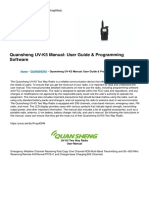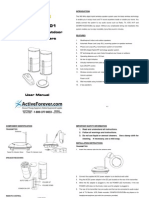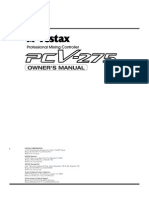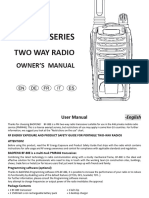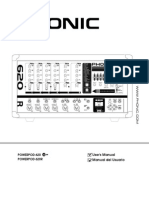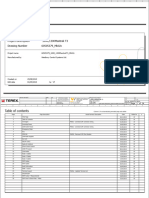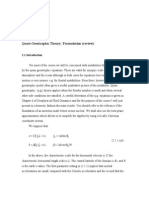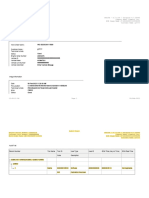Dittel FSG4 Operators Manual PDF
Uploaded by
ablasDittel FSG4 Operators Manual PDF
Uploaded by
ablasFunctional Checks
If the transceiver does not operate satisfactory, check the following:
Is operating frequency channel correctly set?
Is battery capacity sufficient? Carry out a battery test without any charger connected!
Weak signals? Switch OFF the squelch!
Is the transceiver's helical antenna vertically held or is it screened by the operator's body?
Operate radio without any accessory. Same malfunction?
Are helical antenna or antenna plug/ cable damaged?
Is voice level too low or distance to microphone too far?
Does multipath effect occur? Change location.
At radio interference change location. Suppress interference of your car/airplane.
In case of doubt, compare operation of the transceiver with another transceiver on the same
location or call another station. Should the unit require service, please contact your nearest
authorised dealer or certified repair station.
FSG 4
Article-No.: D10003
Issue 01/2009
118.00 136.975 MHz
6 pre-programmed out of 760
< 15 ppm
typ. 1 Watt/ 50 / ca. 3.6 W PEP
0.7 Watt/ 8 @ 12 Vdc
< 1 V/ 50 / 6 dB/ m = 0.3
6 dB/ 5 V 100 mV/ m = 0.3
11.7 15.1 Vdc external
Ni-MH 12 Vdc / 1.5 Ah nominal
9 hrs at 80% RX / 20% TX
15 hrs at 90% RX / 10% TX
24 hrs at 95% RX / 5% TX
45 hrs at 40% RX / 60% standby
Power consumption:
Transmit 450 mA typical
Receive 35 mA typical
Standby 17 mA typical
Operating temperature: -20C +60C
Charging temperature: 0C +40C
Dimensions:
209 84 44.5 mm w/out antenna
Weight:
ca. 900 g
Via accessory jack:
Connection of battery charger,
external 12 Vdc supply, protected
12 Vdc output for special accessory,
additional dyn. microphone 5 to
200 , additional ear/ headphone
min. 30 , ext PTT key
Robust aluminum die-cast case; sidetone via headphone;
battery indicator.
Frequency range:
Number of channels:
Frequency accuracy:
RF carrier output:
AF output power:
Sensitivity:
AGC range:
Supply voltage:
Built-in battery:
Operating time:
(Normal condition)
Safety Information
Ni-MH
024.HB.00E
Before operating the transceiver, please read
this instructions thoroughly!
Keep for future use!
Please observe the Safety Information!
Technical Data
The radio operates in the VHF frequency band, this is a Line-Of-Sight (LOS) frequency;
therefore, siting of the radio greatly affects its operating range. The longest range is normally
obtained when a direct LOS is maintained between the radios. Use of hilltop or tower
locations will increase the LOS range. Location in valleys with intervening hills, behind
buildings or in dense woods may reduce or prevent communications. If possible, avoid
locations near electrical interference sources, such as power and telephone lines, radars,
welders and electrical generators.
This radio contains a Ni-MH battery!
DO NOT dispose worn out Ni-MH batteries with domestic waste. Consumers are
obliged by law to return Ni-MH batteries at the end of their service lives to the
public collecting points set up for this purpose or point of sale.
FOR AIRCRAFT RADIO
COMMUNICATIONS
Operating Instructions
Siting
Every radio, when transmitting, radiates energy into the atmosphere that may, under certain
conditions, cause the generation of sparks. All users of our radios should be aware of the
following warning:
Do not operate radio near flammable liquids or nearby explosive devices.
During normal use, the radio will subject you to radio energy substantially below the level
where any kind of harm is reported.
To ensure personal safety, please observe the following simple rules:
DO NOT transmit when the antenna is very close to, or touching, exposed parts of the
body, especially the face and eyes.
DO NOT transmit inside vehicles or aircraft with the helical antenna, always operate the
radio with a suitable external antenna. Assure appropriate lightning protection where
elevated outdoor antennas are used.
DO NOT hold the transmit (PTT) key in when not actually desiring to transmit.
DO NOT allow children to play with any radio equipment containing a transmitter.
DO NOT operate the radio whilst driving. It should also be noticed that the use of a hand
held microphone while driving could constitute an offence under the Road Traffic Regulations.
VHF / AM 6 Channel
HANDHELD TRANSCEIVER
Approvals and Conformity:
BFS-No.: B-7828/82 and
L-5201/84
FTZ-No.: LO-81/82
FCC ID: BVY8VEFSG4
Dittel Messtechnik GmbH
Avionics Division
Erpftinger Strae 36 86899 Landsberg Germany
Telephone +49 (0)8191/ 3351-0 Fax +49 (0)8191/ 3351-49
Subject to technical change
Printed in Germany
08.03.10
E-Mail: info@dittel.com
Internet: www.dittel.com
General Information
Transmit Operation
This Operating Instruction refers to a handheld Transceiver FSG 4, Article-No. F10199. The
FSG 4 is a radio that is working on six pre-programmed channels out of the 760 channels
within the airband frequency range of 118.000 136.975 MHz (25 kHz increments). The
operation mode is Simplex, which is transmitting or receiving only in turns.
NOTICE:
Before using the radio the first time charge the battery for at least 10 hours with 250 mA.
When using the helical antenna, hold transceiver vertically, preferably with the left hand.
Care for an all-round obstacle free location; the called station
should be within line-of-sight distance.
Do not hold the radio such as the antenna gets very close to, or
touching, exposed parts of the body, especially the face, shoulder
or the eyes.
Please keep radio discipline. The channel must be clear
before transmitting.
Battery Test
Press button "LAMP/BATT. TEST" e for a few seconds (without any charger connected
The LED indicators j will light sequentially
5 LEDs ON
battery fully or nearly fully charged
2 4 LEDs ON
battery partially discharged, reduced operating time.
1 LED ON
battery discharged, charge the battery immediately.
NOTE: Do not discharge battery completely during radio operation (no indicator ON). Selfdischarge of battery when not in use (radio switched OFF) permitted.
Rotate the volume control c clockwise to turn the radio ON. With
the channel switch i set the desired channel number. Press the
push-to-talk button g. Speak loud, slow and clear!
When the built-in microphone is used, speak into the microphone k from a distance of 3 to 5
cm. In noisy environment hold microphone very close to your mouth or use external mike.
After your message release the PTT button g to clear the channel and hear the reply.
Charging the Battery
Receive Operation
1. Connect antenna to the antenna socket d
2. Rotate the VOL control c clockwise to turn the radio ON.
3. With the channel selector switch i set the desired channel number.
WARNING! Channel selector switch stops at 1 and 6! Risk of destruction!
Plug DL-5A charger into accessory jack h. Connect charger to mains.
Observe charging temperature of 0C +40C.
Normal charge: ca. 10 hours with up to 250 mA.
Transceiver not in use should be left connected to the charger. This keeps the batteries fully
charged and allows maximum operating time.
4. To check receiver switch squelch circuit OFF (toggle switch f towards OFF position that
is opposite "SQ"). On a free channel basic receiver noise with steady volume should be
audible.
5. Standard Receive Operation
Continuous charging via h with FSG 4 in operation or switched OFF is permitted.
Use only Walter Dittel GmbH chargers.
Switch the SQ-circuit ON (SQ-toggle switch f towards
position "SQ"). Receiver noise, weak signals and
interference pulses are blocked. Adjust the volume
control c to a desired level.
6. To obtain full receiving radio range switch OFF the
squelch f. Now the radio is noisy during standby
operation but no weak signals are suppressed.
7. In noisy environment hold speaker close to your ear or
use noise cancelling headphone for this purpose.
Change of Pre-set Frequencies (shall be done by authorized personnel only)
Recap accessory jack h after charging.
Remove 4 screws on the back of the transceiver and lift off back shell. Follow the
programming schedule on the Coding PC Board inside the radio.
Accessories
The accessory jack h allows connection of accessories for various applications and operating conditions. When an external dynamic microphone of < 200 DC impedance is
connected, the built-in microphone is automatically switched OFF. In noisy environment a
second loudspeaker or a noise cancelling headphone with at least 30 is recommended.
Pin assignment:
c
d
e
FSG 4
1
2
6
5
Accessory jack h
Top view
f
g
h
Earphone/headphone/loudspeaker, at least 30
Dynamic or special Electret microphone, 5 200
+11.7 15.1 V DC
input to charge the battery
output (switched) to supply VOX 90 and/or special
Electret microphone
supply from 12 V DC car or aircraft battery.
Microphone Ground
Ground (minus power; GND for PTT, AF)
PTT button; common return by g (GND)
Appendix to OPERATING INSTRUCTIONS 024.HB.00E
You might also like
- Audio Unlimited Wireless Speakers ManualNo ratings yetAudio Unlimited Wireless Speakers Manual6 pages
- BFDX Walkie Talkie Radios BF-350 USER'S MANUAL PDF100% (1)BFDX Walkie Talkie Radios BF-350 USER'S MANUAL PDF10 pages
- BAOFENG GT 18 PMR User Manual EN DE FR IT ES 20231031No ratings yetBAOFENG GT 18 PMR User Manual EN DE FR IT ES 2023103168 pages
- 8-Channel Premium Mic/Line Mixer: Owner'S ManualNo ratings yet8-Channel Premium Mic/Line Mixer: Owner'S Manual28 pages
- DVB-T Indoor Aerial SZA 28 A1: Home TechNo ratings yetDVB-T Indoor Aerial SZA 28 A1: Home Tech44 pages
- User and Installation Guide: 2.4 GHZ Digital Wireless HeadphonesNo ratings yetUser and Installation Guide: 2.4 GHZ Digital Wireless Headphones8 pages
- Owner'S Manual: Professional Mixing ControllerNo ratings yetOwner'S Manual: Professional Mixing Controller8 pages
- BFDX Waterproof Walkie Talkie BF-390 USER'S MANUAL PDFNo ratings yetBFDX Waterproof Walkie Talkie BF-390 USER'S MANUAL PDF10 pages
- BAOFENG GT 18 FRS User Manual EN 20231012No ratings yetBAOFENG GT 18 FRS User Manual EN 2023101213 pages
- MDR Rf811r Wireless Stereo Headphone System ManualNo ratings yetMDR Rf811r Wireless Stereo Headphone System Manual12 pages
- Baofeng Uv 5r Two Way Radio Dual Band Walkie Talkie Complete Features Instruction GuidNo ratings yetBaofeng Uv 5r Two Way Radio Dual Band Walkie Talkie Complete Features Instruction Guid21 pages
- 179.193_179.196 PowerDynamics PD781 & PD782 Wireless Microphone_manual_V2.0 (1)No ratings yet179.193_179.196 PowerDynamics PD781 & PD782 Wireless Microphone_manual_V2.0 (1)28 pages
- Powerpod620 Plus R Manual Ingles EspañolNo ratings yetPowerpod620 Plus R Manual Ingles Español32 pages
- Digital-to-Analog Converter Box User Manual: Español EnglishNo ratings yetDigital-to-Analog Converter Box User Manual: Español English43 pages
- Hf/50 MHZ Transceiver: Instruction ManualNo ratings yetHf/50 MHZ Transceiver: Instruction Manual218 pages
- Delco Manuals: Radio Model 633, Delcotron Generator Delco Radio Owner's Manual Model 633, Delcotron Generator InstallationFrom EverandDelco Manuals: Radio Model 633, Delcotron Generator Delco Radio Owner's Manual Model 633, Delcotron Generator InstallationNo ratings yet
- The Baofeng Radio Handbook: A Practical Guide to Getting Started with Baofeng Radio for Emergency Communication, Outdoor Activities, and Everyday UseFrom EverandThe Baofeng Radio Handbook: A Practical Guide to Getting Started with Baofeng Radio for Emergency Communication, Outdoor Activities, and Everyday UseNo ratings yet
- The Baofeng Radio Revolution: The Beginner Guerrilla’s Guide to Break Through the Complexity, Secure Communications, and Prepare for Disaster With Prepper TacticsFrom EverandThe Baofeng Radio Revolution: The Beginner Guerrilla’s Guide to Break Through the Complexity, Secure Communications, and Prepare for Disaster With Prepper TacticsNo ratings yet
- Heat and Mass Balance Condensate Versi AgungNo ratings yetHeat and Mass Balance Condensate Versi Agung6 pages
- 1000 Maxtrak & 1300 Maxtrak Tier 3 Electrical Schematic Number Mk02cNo ratings yet1000 Maxtrak & 1300 Maxtrak Tier 3 Electrical Schematic Number Mk02c15 pages
- Shell Rimula R4 L 15W-40: Performance, Features & Benefits Specifications, Approvals & RecommendationsNo ratings yetShell Rimula R4 L 15W-40: Performance, Features & Benefits Specifications, Approvals & Recommendations2 pages
- Ficha Tecnica Driver Done Brasil PremiumNo ratings yetFicha Tecnica Driver Done Brasil Premium6 pages
- Simple Secrets To Totally Rocking Your Handyman ServicesNo ratings yetSimple Secrets To Totally Rocking Your Handyman Services3 pages
- Liquid Drop Model and Bohr-Wheeler Theory of Nuclear Fission100% (1)Liquid Drop Model and Bohr-Wheeler Theory of Nuclear Fission6 pages
- Practice Problems - Chapter 33 Alternating Current Circuits: Multiple ChoiceNo ratings yetPractice Problems - Chapter 33 Alternating Current Circuits: Multiple Choice4 pages
- Waukesha Upgradation Kit G-962-540 - BOMNo ratings yetWaukesha Upgradation Kit G-962-540 - BOM2 pages
- BFDX Walkie Talkie Radios BF-350 USER'S MANUAL PDFBFDX Walkie Talkie Radios BF-350 USER'S MANUAL PDF
- BAOFENG GT 18 PMR User Manual EN DE FR IT ES 20231031BAOFENG GT 18 PMR User Manual EN DE FR IT ES 20231031
- User and Installation Guide: 2.4 GHZ Digital Wireless HeadphonesUser and Installation Guide: 2.4 GHZ Digital Wireless Headphones
- BFDX Waterproof Walkie Talkie BF-390 USER'S MANUAL PDFBFDX Waterproof Walkie Talkie BF-390 USER'S MANUAL PDF
- MDR Rf811r Wireless Stereo Headphone System ManualMDR Rf811r Wireless Stereo Headphone System Manual
- Baofeng Uv 5r Two Way Radio Dual Band Walkie Talkie Complete Features Instruction GuidBaofeng Uv 5r Two Way Radio Dual Band Walkie Talkie Complete Features Instruction Guid
- 179.193_179.196 PowerDynamics PD781 & PD782 Wireless Microphone_manual_V2.0 (1)179.193_179.196 PowerDynamics PD781 & PD782 Wireless Microphone_manual_V2.0 (1)
- Digital-to-Analog Converter Box User Manual: Español EnglishDigital-to-Analog Converter Box User Manual: Español English
- Delco Manuals: Radio Model 633, Delcotron Generator Delco Radio Owner's Manual Model 633, Delcotron Generator InstallationFrom EverandDelco Manuals: Radio Model 633, Delcotron Generator Delco Radio Owner's Manual Model 633, Delcotron Generator Installation
- The Baofeng Radio Handbook: A Practical Guide to Getting Started with Baofeng Radio for Emergency Communication, Outdoor Activities, and Everyday UseFrom EverandThe Baofeng Radio Handbook: A Practical Guide to Getting Started with Baofeng Radio for Emergency Communication, Outdoor Activities, and Everyday Use
- The Baofeng Radio Revolution: The Beginner Guerrilla’s Guide to Break Through the Complexity, Secure Communications, and Prepare for Disaster With Prepper TacticsFrom EverandThe Baofeng Radio Revolution: The Beginner Guerrilla’s Guide to Break Through the Complexity, Secure Communications, and Prepare for Disaster With Prepper Tactics
- 1000 Maxtrak & 1300 Maxtrak Tier 3 Electrical Schematic Number Mk02c1000 Maxtrak & 1300 Maxtrak Tier 3 Electrical Schematic Number Mk02c
- Shell Rimula R4 L 15W-40: Performance, Features & Benefits Specifications, Approvals & RecommendationsShell Rimula R4 L 15W-40: Performance, Features & Benefits Specifications, Approvals & Recommendations
- Simple Secrets To Totally Rocking Your Handyman ServicesSimple Secrets To Totally Rocking Your Handyman Services
- Liquid Drop Model and Bohr-Wheeler Theory of Nuclear FissionLiquid Drop Model and Bohr-Wheeler Theory of Nuclear Fission
- Practice Problems - Chapter 33 Alternating Current Circuits: Multiple ChoicePractice Problems - Chapter 33 Alternating Current Circuits: Multiple Choice
